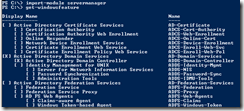Ctrlq.org is a RSS search engine. It is a single purpose web site that finds RSS feeds based on any search terms you enter.
Thursday, May 5, 2011
Wednesday, May 4, 2011
Tuesday, May 3, 2011
Change your default printer depending on your location with Windows 7
Windows 7 includes an option to change the default printer depending on what network location is used. To configure this feature, access the Devices and Printers dialog box. Select one printer to display additional menu selections. Then click on the “Manage default printers” menu option.
A new dialog box should appear with drop-down boxes for both network locations and printers.
One location entry is “no network”, which could be used for a XPS or PDF print queue when no network connectivity is available.
Monday, May 2, 2011
VMware File Types
Below are some common file types found within a VMware environment.
.nvram
BIOS for the virtual machine; an example would be the number of hard drives present.
.vmdk
Actual virtual hard drives for the virtual guest operating system.
.xmsd
Stores information about snapshots.
.vmsn
Stores the exact state of the virtual machine when a snapshot is taken.
.vmx
Primary configuration file for the virtual machine.
.vmxf
XML file that contains additional information if the virtual machine has been added to a team.
.vmtm
Contains team membership information if the virtual machine is participating in a team.
.vmem
Backup of the virtual machine’s page file.
.vmss
Suspended state file, if a virtual machine is suspended.
.vswp
VMkernel swap file; by default, it will equal the size of RAM configured within the VM.
.vmtx
Template file
Sunday, May 1, 2011
Bulk Rename Utility
The Bulk Rename Utility is a free file renaming software for Windows; it allows you to easily rename files and entire folders based upon extremely flexible criteria.
Enumerate roles on a Windows 2008 R2 Server using PowerShell
The two PowerShell commands below will enumerate roles on a Windows 2008 R2 Server. The same data can be found via the Server Manager GUI, but the PowerShell option can create an overall list.
import-module servermanager
get-windowsfeature


